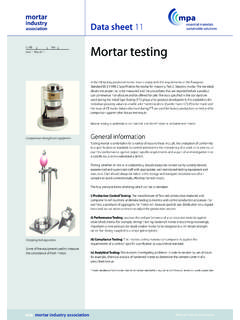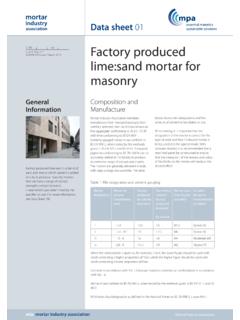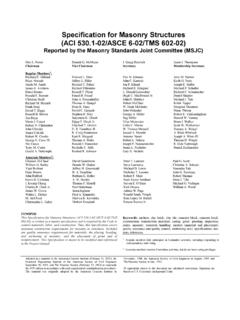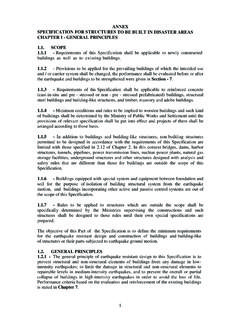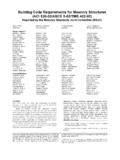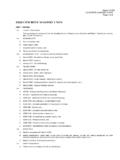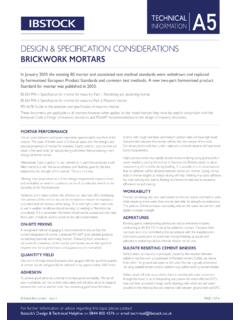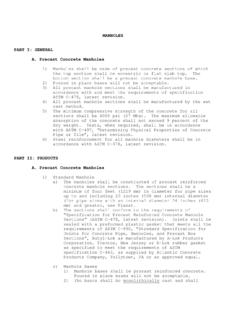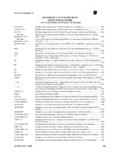Transcription of CI/SfB Issue 1 June 2013 Yq4 The Specification of an ...
1 IntroductionThe constituent materials and theproportions of those in the mixdetermine the properties of a masonrymortar in both the fresh and hardenedstates. The relationship between the freshand hardened properties of mortar iscomplex; it being impossible to considerindividual properties, in either state, drafting a Specification for a masonrymortar it is important to remember thefunctions that the mortar has in masonryconstruction: To act as an adhesive (to glue) the masonry units together, To glue joint reinforcement and connectors to the masonry units, To act as a spacer between masonry units, To compensate for irregularities between masonry units, To seal any gaps to minimise rain or wind penetration, To have sufficient strength to suit the application, To be durable in the particular addition the colour of hardenedmasonry mortar contributes to theoverall aesthetic appearance of thefinished construction, therefore theappropriate colour may have to bespecified where the mortar is EN 998-2 classifies mortar in terms ofits properties and end use.
2 Three types ofmortar have been identified: General purpose masonry mortar Designed Prescribed Lightweight masonry mortar Thin layer masonry mortarThe Specification ofan Appropriate MortarFresh propertiesFresh masonry mortar must have a sufficientlevel of workability in order to achievesatisfactory adhesion. Mortar that does notmeet this criterion will not mould to theshape of the masonry unit resulting in theentrapment of air and consequent poorbond strength development. The appropriatelevel of workability is dependent on theabsorption, mass and surface texture of themasonry use of hydrated lime in mortars candeliver improved workability and open timeas well as reducing the effects of suction andthe risks of specifier needs to ensure that theselected mortar is appropriate for the pointof application for example the strength ofdesigned masonry or overall durabilityaspects of the structure being should be given to thecompatibility of the mortar strength withthe physical characteristics of the brick,block or masonry .
3 Mortars that are strongerthan the units they are bonding can resultin cracking of the a particular compressive strengthbe required then a designed mortar mustbe achieve long-term durability in masonryconstruction, consideration has to be givennot only to the physical characteristics of themasonry unit but also to the mortar andexposure conditions. Table 15 PD 6697entitled Durability of masonry in finishedconstruction ; lists various exposureconditions, types of masonry units andDefinitionsDesigned masonry mortar:Mortar with acomposition and method of manufacturethat is chosen by the producer in order toachieve specified masonry mortar: Mortar made topredetermined proportions the properties ofwhich are assumed from the statedproportions of the masonry mortar:Designedmasonry mortar with a dry hardened densitybelow a prescribed layer masonry mortar:Designedmasonry mortar with a maximum aggregatesize less than or equal to a prescribed Specification ofMasonry MortarA number of parameters should beconsidered when specifying a masonrymortar, these include.
4 The required hardened strength, Appearance, Durability, Fire resistance, Thermal insulation, Sound guidance on the selection of anappropriate mortar for a particularapplication may be found in Table 15 of PD6697. Where special requirements areapplicable discussions should take place withthe mortar producer to determine anappropriate Specification which takesaccount of the actual constituent materials tobe of the parameters required in thespecification of a masonry mortar are nowconsidered:mia mortar industry associationMineral Products AssociationYq4 Issue 1 June 2013CI/SfBData sheet23appropriate mortar designations. The Specification of a mortar containing anair-entraining admixture improves theresistance of the mortar to freeze Standard Code of Practice 1996-1-1states that lime based mortars resist rainpenetration through external walls moreeffectively than any other use of a cementitious materialcontaining ground granulated blast furnaceslag or fly ash increases the resistance of themortar to sulfate attack in should be given to architecturaldetailing (overhangs, copings etc) to preventthe masonry becoming saturated.
5 Water cancome from a number of sources, for examplerainwater falling directly on the masonry orthe upward movement of water wheremasonry is placed below ground or in aretaining wall. In the case of retaining wallsthe use of weep holes and impermeablemembranes should be reducing admixtures may alsobe incorporated in the mortar mix: thesereduce the quantity of capillary absorptioninto the mortar. Specifiers should note thatthe use of these admixtures reducepermeability but do not provide colour of a hardened masonry mortarcontributes to the overall aestheticappearance of the finished should be specified by reference tothe mortar producers colour range. Where the specifier requires a non standardcolour, discussions should be undertakenwith the mortar producer at an early stageto ensure consistency of supply for theduration of the contract.
6 In all instances, it is strongly recommendedthat reference panels are always prepared toassess the suitability of the mortar to meetthe specifiers expectations, taking intoaccount variations in masonry units,workmanship, masonry joint profile, localweathering conditions, pigments, fineaggregates and cements that may affect thefinal colour and resistanceBS EN 1996-1-2:2005 provides guidance onthe notional fire resistance of walls, tables listthe thickness of masonry types required fordifferent time periods of fire resistance basedon the composition of the insulationLegislation now attaches increasedimportance to the efficient use of energyresources. Designers should design externalwalls of buildings to minimise the quantity ofenergy required to maintain the requiredinternal temperature.
7 Specialist publicationsare available to assist the designer to specifyMortar SelectionFigure 1 provides guidance on the selection of a suitable mortar for some 1 Location within the structureInternalExternalInternal wallsMortar class: M4 Designation: (iii)Exposure conditionsWalls in areas of severeor very severeexposure to frostattack above dpc (2)Mortar class: M12 Designation: (i)General externalconditions (3)Mortar class: M4 Designation: (iii)orMortar class: M6 Designation (ii)Walls below dpc (1)Retaining wallsMortar class: M12 Designation: (i)Cappings, copingsand sills (3)Mortar class: M12 Designation: (i)orMortar class: M6 Designation (ii)1In external situations where high levels of sulfates are present, (below or near dpc level or in areas of severe wind driven rain) the use of a mortar with enhanced sulfate resisting properties is on areas where exposure to severe frost attack occurs may be found in a number of specialist publications ( NHBC Standards) or advice may be sought from MIA members.
8 This classification is based on three criteria, a frost incidence of over 60 days a year, rainfall of over 1000mm per year and an elevation of over 90m above sea level. This classification embraces Scotland, most of Northern England and finally selected mortar class or designation to reflect the assessed degree of and the design of insulatedmasonry. Part L of the Building Regulations isentitled Conservation of fuel and power ,and provides data on the thermalconductivity of mortar and insulationThe transmission of sound through solidmaterial occurs as a result of vibrations beingset up in the material. For good soundinsulation it is essential that all mortar jointsare fully filled.
9 Further guidance may befound within Part E of the BuildingRegulations, in the section entitled Resistance to the passage of sound .There is a real danger of contact dermatitis orserious burns if skin comes into contact withwet mortar. Wear suitable protective clothingand eye protection. Where skin contact occurseither directly or through saturated clothingwash immediately with soap and water. For eyecontact immediately wash out eyes thoroughlywith clean water. If swallowed wash out mouthand drink plenty of water. The relevant codes of practice, standards andstatutory regulations must always be information in this data sheet may be freelycopied with acknowledgement to the MortarIndustry Association.
10 Current Issue numbers ofall MIA publications are available from the Mortar Industry Association is part of theMineral Products Association, the tradeassociation for the aggregates, asphalt,cement, concrete, dimension stone, lime,mortar and silica sand industriesMineral Products Association LtdGillingham House 38 - 44 Gillingham StreetLondon SW1V 1 HUTel +44 (0)20 7963 8000 Fax +44 (0)20 7963 Mineral Products Association 2013BS EN 998-2-2010 Specification for mortar for masonry - Part 2: masonry mortarPD 6697:2010 Recommendations for the design of masonry structures to BS EN 1996-1-1 and BS EN 1996-2BS EN 1996-1-2:2005 Design of masonry structures - General rules Structural Fire Design*BS 5628:Part 1:2005 Code of practice for use of masonry .

